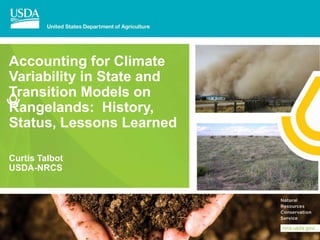
July 29-130-Curtis Talbot
- 1. Accounting for Climate Variability in State and Transition Models on Rangelands: History, Status, Lessons Learned Curtis Talbot USDA-NRCS
- 2. USDA-NRCS-National Ecological Site Handbook
- 3. Loamy Plains Range Site Description MLRA 49 & 70 USDA-NRCS-Colorado FOTG July 1981
- 4. Sandy Ecological Site Description MLRA 42 Ecosystem Dynamics Interpretive Tool June 2019
- 5. Sandy Ecological Site Description MLRA 42 Ecosystem Dynamics Interpretive Tool June 2019
- 6. Sandy Ecological Site Description MLRA 42 Ecosystem Dynamics Interpretive Tool June 2019 How can we capture climate change in the data?
- 7. Albuquerque Climate 1920-2009 1920-49 1930-59 1940-69 1950-79 1960-89 1970-99 1980-09 1990-19 2000-29 2010-39 2020-49 6.5 7 7.5 8 8.5 9 9.5 10 55.5 56 56.5 57 57.5 58 58.5 59 59.5 60 60.5 Precipitation(“) Temperature (F) Western Regional Climate Center wrcc@dri.edu Environmental Protection Agency What climate change may mean for the Albuquerque region 2014
- 8. How can we capture climate change in the STM? Reference State (Grassland with scattered shrubs) Projected State (Shrub dominance with increased bare patches) Climate Change Or…
- 9. How can we capture climate change in the STM? Climate Change
- 10. Factors to consider with projected climate change… • Models project linear change, but the “peaks and valleys” may have a greater impact on natural resources • For the Desert Southwest, most models predict an increase in high-intensity storm events • High-intensity storm events often serve as triggers for transitions between ecological states • Flooding • Lightning strike fires • Climate averages may remain stable, but seasonality could change
- 11. Factors to consider with projected climate change… • Plant and animal response to climate change may occur at a different temporal scale than the climate • Episodic weather events may eliminate certain species (or at least certain populations) • In order for plant species to take advantage of decreased competition, they must have access to their preferred vectors of spreading • Wind • Flooding • Carrier species (including humans) • Many plant species have a narrow climate range for germination, but can tolerate a wider range once established • Topography will impact the spread of species
- 12. Final thoughts… • Any attempts to model climate change in the ecological site description must be applicable to management, both temporally and economically • NRCS has a relatively new ecological site database, which will likely be the platform for displaying and interpreting the state & transition model • Ecosystem Dynamics Interpretive Tool • edit.jornada.nmsu.edu
- 13. Thank you! • Questions and /or comments? • Suggestions for future model / database development regarding climate change on rangeland, contact: • Brandon Bestelmeyer • brandon.Bestelmeyer@ars.usda.gov • Joel Brown • joel.brown@usda.gov • Curtis Talbot • curtis.talbot@usda.gov “The findings and conclusions in this presentation are those of the authors and should not be construed to represent any official USDA or U.S. Government determination or policy.”
Hinweis der Redaktion
- GO TO VIEW > MASTER > SLIDE MASTER TO EDIT THE IMAGES ON THE TITLE AND DIVIDER SLIDES
- National Ecological Site Handbook specifies that climate is one of the factors that define an ecological site. However, NESH guidance regarding climate variability is non-existent.
- Range site descriptions contained a climatic summary comprised of precipitation and temperature.
- Climate section hasn’t changed dramatically in 40 years. Text has grown longer. Inclusion of graphs. Typically based on the last three complete decades of climate data. Normalizes the extremes. Backward looking.
- Current use of the state & transition model often accounts for climate (weather) variability (usually drought & rainfall patterns on rangeland). Transitions seldom contain a time reference. Still does not capture the concept of climate change.
- As mentioned earlier, typically based on the last three complete decades of climate data. We know these data change, but seldom get updated due to limited resources.
- If ecological site descriptions were updated every decade, this displays the current and previous six 30-yr time periods based on date from WRCC. Each decade of data gets represented three times. The ‘80s were a wet decade across most of the West, responsible for the “spike” in ppt. The ‘80s were also a cooler decade, getter consistently warmer since then. Notice the relative distance between the first five datasets, vs. the last seven datasets. The italicized data points represent projections from EPA.
- One possibility is to add a novel state by way of a “climate change” transition. If this option is accepted, a trigger or threshold must be defined to know when to move to the projected state
- Another possibility is to add an entirely new STM to represent projected climate change. This might be accomplished by looking at ecological sites from adjacent MLRAs or LRUs that represent a similar climate as that projected by climate change models. For example, Albuquerque currently sits as a transition of the Chihuahuan Desert at its northern extent. Following the EPA model, perhaps we should be projecting STMs from a more central Chihuahuan Desert concept.
